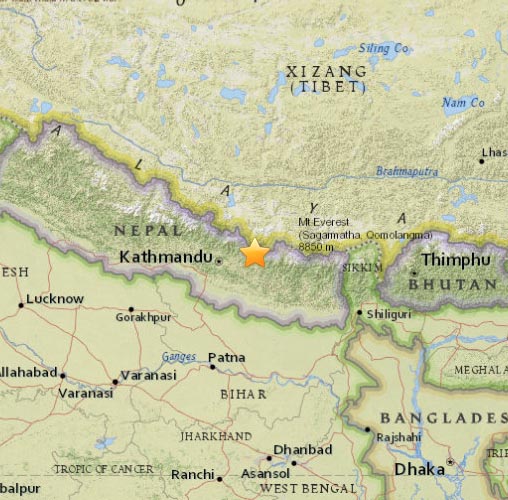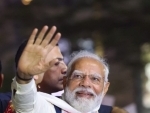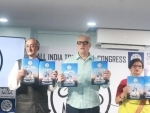
36 dead in Nepal quake, 17 killed as tremors rock India
At least 1000 people have been injured in the Himalayan nation by the fresh quake.
Several houses have been damaged in Nepal which was hit by a massive quake and several aftershocks in recent times.
According to the U.S. Geological Survey, the earthquake registered 7.3 on the Richter scale, occurred at 12.45 pm(local time). The ground shook for at least 25 seconds.
Apart from the 7.3 earthquake, aftershocks were also experienced by the nation.
The aftershocks ranged from 4.2 to 6.2 on the Richter Scale, India Meteorological Department website said on Tuesday.
Initial reports suggested that the epicentre was Afghanistan but it, later it was changed to Zham on the China-Nepal border about 83 kms east of Kathmandu and then finally to Kodari, Nepal.
The airport in Kathmandu was shut down soon after the quake.
Three major landslides were also reported in Nepal's Sindhupalchowk region.
According to Nepal TV, the government has extended the closure of educational institutions by another two weeks. They had been ordered shut after April 25 and a review was to be taken on May 14, the last day of the Nepali month of Baisakh.
The Nepal Police tweeted, "Please stay in open field, help us make free road, do not make phone now busy. SMS is suggested."
The April 25 quake, which has devastated the Himalayan nation, has so far killed more than 8000 people and left more than 17,000 injured.
Continuing the efforts by the Indian Air Force (IAF) to help Nepal which was struck by severe earthquakes in recent times, relief was being provided to the people in distress across Nepal including remote and inaccessible areas.
Six IAF Medium Lift Helicopters (MLH) are positioned at Kathmandu. Two MLHs are positioned at Pokhara.
The most affected areas where casualty evacuation were carried in the past few days are Chautara, Charkot, Dhading, Melum, Lukla, Aroghat, Dhunche, Trishuli, Ramchap, Barpak, Narayan Chor, Namchi Bazar and Tatopani.
"Till 0800 hrs today, 51 sorties were carried out by helicopters evacuating 155 people to safer places. 01 casualty was evacuated. The load carried by these helicopters till 0800hrs today was 17.9 tons," an IAF statment said.
One mission was carried out by C-17 transport aircraft carrying 25 tons of load.
The Indian Army also continued to provide aid to affected population and areas in close coordination and cooperation with the Nepal Army.
The ALHs continue to be employed for rescue efforts in Pokhara and adjoining areas in spite of weather and terrain limitations and have conducted 30 sorties, evacuated 2 persons, moved 11 others apart from delivering 25.6 tons of relief material since May 9. Army and IAF Helicopters combined have moved over 56.69 tons of relief stores in the last three days alone.
The Everest Team which was located at Namchi Bazaar when the earthquake struck on Tuesday has been reported to be safe and moving towards Syangboche Airfield.
Meanwhile, 17 deaths have been reported from India where tremors were felt in Delhi, Bihar, Bengal, Odisha, Assam, Gujarat, Sikkim and Himachal. People of Chennai in Tamil Nadu also felt the quake.
Prime Minister Narendra Modi called a meeting and directed authorities to be on alert for rescue and relief operations.
"Prime Minister, Shri Narendra Modi, today took stock of the situation following the fresh major earthquake felt in Nepal and parts of India, at a high-level meeting," the Prime Minister's Office said in a statement.
"The Prime Minister directed all concerned authorities to be on alert for carrying out rescue and relief operations, as required," it said.
In Delhi, buildings trembled for more than a minute and people ran into the streets. Metro services were halted for some time.
Following the quake, Metro Railway services were suspended in Kolkata.
Union Home Minister Rajnath Singh said: "News of an earthquake hitting Nepal again has come. Several parts of India also felt the tremors. MHA is collecting more details and info."
The Home Ministry said teams of National Disaster Response Force(NDRF) have been put alert.
"Please do not panic and maintain calm. Earthquake situation is being closely monitored and officials are already in the field," Delhi Chief Minister Arvind Kejriwal said.
People in many places, like in Gurgaon of National Capital Region, rushed out of their homes and offices. In Siliguri in north Bengal people also rushed out of offices.
West Bengal CM Mamata Banerjee tweeted: "I appeal to our people to maintain calm. Our Government will provide all support #earthquake."
In Bihar towns and like Gaya and Madhubani felt strong tremors.
Sikkim in northeast, which also borders Nepal, also felt it strongly.
According to US Geological Survey, seismicity in the Himalaya dominantly results from the continental collision of the India and Eurasia plates, which are converging at a relative rate of 40-50 mm/yr.
Northward under thrusting of India beneath Eurasia generates numerous earthquakes and consequently makes this area one of the most seismically hazardous regions on Earth. The surface expression of the plate boundary is marked by the foothills of the north-south trending Sulaiman Range in the west, the Indo-Burmese Arc in the east and the east-west trending Himalaya Front in the north of India.
The India-Eurasia plate boundary is a diffuse boundary, which in the region near the north of India, lies within the limits of the Indus-Tsangpo (also called the Yarlung-Zangbo) Suture to the north and the Main Frontal Thrust to the south.
The Indus-Tsangpo Suture Zone is located roughly 200 km north of the Himalaya Front and is defined by an exposed ophiolite chain along its southern margin.
The narrow (<200km) Himalaya Front includes numerous east-west trending, parallel structures. This region has the highest rates of seismicity and largest earthquakes in the Himalaya region, caused mainly by movement on thrust faults. Examples of significant earthquakes, in this densely populated region, caused by reverse slip movement include the 1934 M8.1 Bihar, the 1905 M7.5 Kangra and the 2005 M7.6 Kashmir earthquakes.
The latter two resulted in the highest death tolls for Himalaya earthquakes seen to date, together killing over 100,000 people and leaving millions homeless. The largest instrumentally recorded Himalaya earthquake occurred on 15th August 1950 in Assam, eastern India. This M8.6 right-lateral, strike-slip, earthquake was widely felt over a broad area of central Asia, causing extensive damage to villages in the epicentral region.
Support Our Journalism
We cannot do without you.. your contribution supports unbiased journalism
IBNS is not driven by any ism- not wokeism, not racism, not skewed secularism, not hyper right-wing or left liberal ideals, nor by any hardline religious beliefs or hyper nationalism. We want to serve you good old objective news, as they are. We do not judge or preach. We let people decide for themselves. We only try to present factual and well-sourced news.







